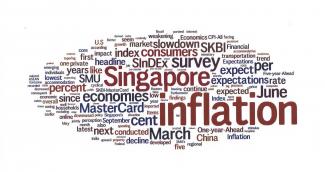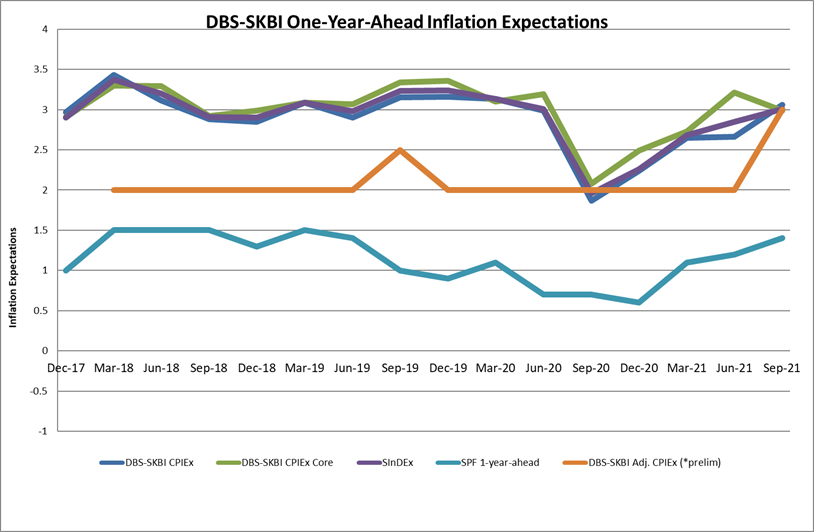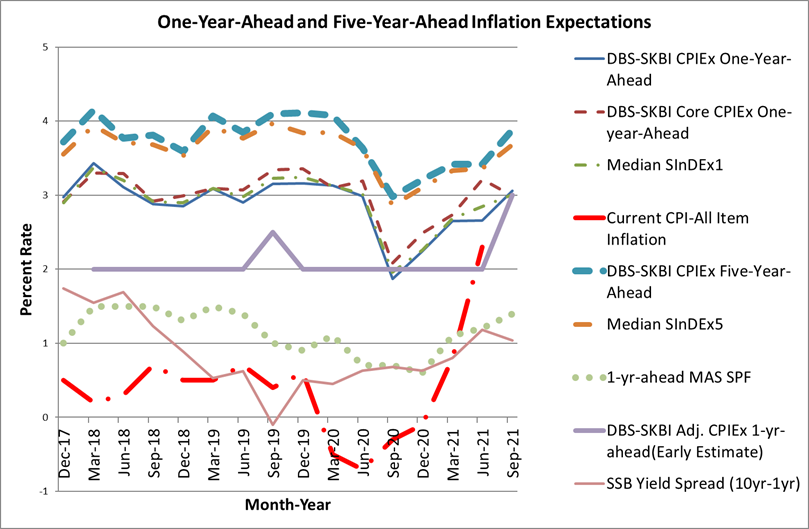
- One-year-Ahead headline inflation expectations elevated to 3.1% in September 2021, compared to 2.7% in June 2021. Headline inflation expectation resumed its upward trend since September 2020, flattening temporarily in June 2021. However, it is still a lower reading than the historical (2011-2020) third quarter average of 3.3%.
- As a comparison benchmark, the Monetary Authority of Singapore’s Survey of Professional Forecasters (MAS SPF) data released in September 2021 showed that the median forecasts of CPI All-Items inflation for 2022 was 1.4%, up from 1.2% in the June 2021 survey. The latest release from the Department of Statistics showed that average CPI-All Items in January–August 2021 was 1.8% higher compared to the reading in the same period last year, while the latest August 2021 monthly inflation is 2.4%, year-on-year. The Monetary Authority of Singapore in their most recent policy review in October 2021 decided to tighten the monetary policy by raising slightly the slope of the Singapore dollar Nominal Effective Exchange Rate (S$NEER) for the first time since 2018 to “ensure price stability over the medium term.”
- The overall CPIEx Inflation Expectations, after adjusting for potential component-wise behavioural biases and re-combining across components, increased to 3.7% in September 2021 from 2.5% in June 2021. This is the biggest jump in this behaviorally adjusted index since we started keeping track of it in March 2019. Inflation expectations for majority of the components like food, transportation, housing & utilities, healthcare, recreation & culture, clothing & footwear, and miscellaneous goods & services, like personal care and personal effects, witnessed at least moderate increases. Mean-while inflation expectations for education, household durables & services as well as communication have remained unchanged from the June 2021 survey.
- We also observed that the free response behaviourally adjusted overall inflation expectations increased to 3.0% in September 2021 compared to 2.0% polled in June 2021 survey. This broad-based increase of inflation expectations across components as well as the aggregated measure after adjusting for potential behavioural biases signal a degree of concern across the population that pandemic related disruptions in global supply chains and concomitant increase in energy and commodity prices might result in an upward pressure on inflation in the medium term.
- In the September 2021 wave, continuing the analysis we embarked on since September 2020, an in-depth survey on the potential impact of Covid-19 on inflation expectations of different components of CPI was conducted. We found that the inflation expectations for food, healthcare as well as overall One-year-Ahead and Five-year-Ahead inflation expectations were expected to have a limited positive impact from Covid-19. However, for most components including transportation, housing & utilities, education, communications, household durables & services, recreation & culture, clothes & footwear and miscellaneous goods and services, respondents did not expect an uptick due to Covid-19.
- Following the academic work by Alberto Cavallo of Harvard Business School (2020) and the UK Office of National Statistics (ONS), respondents were asked if there were any substantive changes to their consumption basket. In September 2021, results suggest there is some limited increase in household spending on housing & utilities, which seem to offset lower transportation expenses. Given the prevalence of work-from-home arrangement during the Preparatory and Stabilisation phases, many employees incur lower transportation cost but higher utility expenses.
- Excluding accommodation and private road transportation related costs, the One-year-Ahead CPIEx core inflation expectations pared to 3.0% in September 2021 (from 3.2% in June 2021). This result signals some cognitive dissonance among respondents compared to other measures which seems to indicate a little upswing in broad-based inflation expectations owing mainly to supply chain disruptions and energy price increases. However, the main headwind of global inflation increases is a downward revision in growth forecasts from the International Monetary Fund.
- For a subgroup of the population who owns their accommodation and uses public transport, the One-year-Ahead CPIEx core inflation expectations also increased to 3.0% in September 2021 from 2.7% in June 2021. Not being exposed to expenses related to private road transportation or housing rentals, this subgroup’s expectations of core inflation closely resemble the Singapore Core Inflation Expectations. The trend is consistent with the general inflation expectations.
- The One-year-Ahead composite index SInDEx1 that puts less weight on more volatile components like accommodation, private road transport, food and energy related expenses polled at 3.0% in September 2021 compared to 2.9% in June 2021. This remained below the third quarter average of 3.3% since the survey’s inception in 2011 till 2020.
- In September 2021, around 64% of the survey respondents reported their belief that Covid-19’s impact on inflation would be significant compared to 70% in June 2021. The share of survey respondents who feel that Covid-19 will have long-term impact on inflation similarly declined to around 68%, from about 73% in June 2021. Both results indicate a high vaccine rollout with more than 80% fully vaccinated individuals and opening up of the vaccinated travel lanes might have increased the prospects of the reopening the economy, with an endemic Covid-19 as the new normal.
- In addition, around 13.6% of the Singaporeans polled expect a more than 5% reduction in salary in the next 12 months, this is slightly higher compared to 12.5% in June 2021. The median salary increment expectation stayed between -1% and 1%.
- As a measure of the tradeoff between prioritising economic growth compared to the cost to life, the so-called livelihood over life debate, the ratio was 2.2 in September 2021, lower than 3.1 in June 2021. This means for every person who prioritised life over livelihood, there are two who prioritised livelihood over life. This also indicates a level of divergence among Singaporeans, with some who feel the economy should be reopened fully to generate some semblance of growth and creating jobs, while others feel that protecting lives should be considered with utmost priority.
Figure 1: One-year-Ahead-inflation expectations: The chart shows the quarterly DBS-SKBI CPIEx (CPI-All Item) and DBS-SKBI CPIEx Core (Excluding accommodation and private road transportation components) One-Year-Ahead Inflation Expectations polled in the quarterly online Singapore Index of Inflation Expectations (SInDex) Survey conducted September 7-17, 2021.
DBS Chief Economist and Managing Director of Group Research, Dr. Taimur Baig commented, “Incorporating local and global developments in their information set, Singaporeans expect around 3% inflation in the coming year. This is consistent with the cycle of economic normalisation and some supply side disruptions visible globally. The survey results provide important insights into the areas of consumer concern, which should be very valuable to market participants, businesses, and policy makers.”
SMU Assistant Professor of Finance and founding Principal Investigator of the DBS-SKBI SInDEx Project, Aurobindo Ghosh highlighted, “Responding to global cues like the energy shortages in China, pandemic induced global supply chain disruption including chip shortages and cyclical increase in energy and commodity prices, One-Year-Ahead inflation expectations among Singaporeans increased both in an aggregate sense and for major components like food, transportation, housing & utilities, and healthcare, among others. With employees continuing to work from home, consumption baskets are changing somewhat. Our survey suggests that respondents are spending more on housing and utilities while reducing their consumption on transportation.”
“However, with possibly cognitive overload with information from multiple sources, consumer survey-based inflation expectations are often biased. Even after adjusting for some behavioural biases, we find a significant jump in the perception of One-Year-Ahead Inflation expectations, the highest since we started collecting the data of these components in 2019. While interpreting most survey-based measures of inflation expectations, policymakers and academics conclude that the change of direction of inflation expectations is more informative than the levels themselves. In sum, we can conclude, that there is indeed a broad-based increase in One-Year-Ahead inflation expectations possibly as reactions to global cues and medium-term domestic price pressures from pandemic restrictions,” Prof Ghosh noted.
For the longer horizon, the Five-year-Ahead CPIEx inflation expectations jumped to 3.9% in the September 2021 survey compared to 3.4% from June 2021. The current polled number is still lower than the third quarter average of 4.1% since the survey’s inception in 2011 till 2020.
The Five-year-Ahead CPIEx core inflation expectations (excluding accommodation and private road transportation related costs) also increased to 3.6% in September 2021 compared to 3.3% in June 2021. Overall, the composite Five-year-Ahead SInDEx5 also increased to 3.7% in September 2021 from 3.4% in June 2021. In comparison, the third quarter average value of the composite Five-year-Ahead SInDEx5 was 4% since the survey’s inception in 2011 till 2020.
“The International Monetary Fund, in their semi-annual World Economic Outlook released this month, reflected on the challenges to recovery. These include ‘…subdued employment growth, rising inflation, food insecurity…’ posed by a persistent pandemic despite extolling the immediate policy reactions which might have staved off another financial crisis. We find long term inflation expectations, both the raw numbers and those adjusted for behavioural biases, seem to be stable and reacting to global cues in September 2021. This is an indication of some degree of anchoring of inflation expectations. Having said that, we also observe some divergence of views of the way forward among Singaporeans, as reflected in the life and livelihood debate in September 2021 where two respondents chose to prioritise livelihood over life for every respondent who chose life over livelihood, down from three in the June 2021 survey, ” Professor Ghosh commented.
Figure 2: Five-year-Ahead-Inflation Expectations in Singapore: The chart shows the quarterly DBS-SKBI CPIEx (CPI-All Item), DBS-SKBI CPIEx Core (excluding accommodation and private road transportation components), SInDEx (Composite index with lower weights on volatile components like food, energy, accommodation and private road transportation) One-Year and Five-Year-Ahead Inflation Expectations polled online quarterly for the Singapore Index of Inflation Expectations (SInDex) Survey conducted September 7-17, 2021. The chart shows a preliminary estimate of Behaviourally Adjusted One-year-Ahead overall DBS-SKBI Adjusted CPIEx. As comparison benchmarks, the chart provides the most recent quarterly CPI-All Item Inflation, MAS Survey of Professional Forecasters median One-year-Ahead CPI-All Item inflation forecasts and the yield spread of 10-year and 1-year Singapore Savings Bonds (SSB).
Methodology
DBS-SKBI SInDEx survey yields CPIEx Inflation Expectations (estimating headline inflation expectations) and related indices are products of the online survey of around 500 randomly selected individuals representing a cross section of Singaporean households. The survey is led by Principal Investigator Dr. Aurobindo Ghosh, Assistant Professor of Finance (Education) at Lee Kong Chian School of Business, SMU. The online survey, powered by Agility Research and Strategy, helps researchers understand the behaviour and sentiments of decision makers in Singaporean households. DBS Group Research is a co-sponsor and research partner with the Sim Kee Boon Institute for Financial Economics (SKBI) at SMU.
The quarterly DBS-SKBI SInDEx survey has also yielded two composite indices, SInDEx1 and SInDEx5. SInDEx1 and SInDEx5 measure the One-year inflation expectations and the Five-year inflation expectations, respectively. The sampling was done using a quota sample over gender, age and residency status to ensure representativeness of the sample. Employees in some sectors like journalism and marketing were excluded as that might have an effect on their responses to questions on consumption behaviour and expectations.
The DBS-SKBI SInDEx survey was augmented in June 2018, based on a joint research study conducted by SMU researchers in collaboration with MAS and the Behavioral Insights Team, where respondents were polled on their perceptions of components of the Consumers Price Index (CPI) and adjusted for possible behavioural biases prevalent in online surveys.
Based on the recommendations of the joint study, since March 2019 the research team has polled the One-year-Ahead inflation expectations of all of the major components of CPI-All Items inflation. The behaviourally adjusted component-wise inflation expectations have increased in most categories like Food, Housing and Utilities, Transportation, Healthcare, recreation & culture, Clothing & Footwear and Miscellaneous Goods & Services; however it stayed unchanged for Education, Household durables & Services and Communications. In free response answers, compared to June 2021 survey, respondents in the September 2021 survey polled One-year Ahead and Five-year Ahead headline and core inflation expectations to increase.
We introduced a new ratio in the June 2020 survey, on the life versus livelihood debate as an aftermath of the Covid-19 pandemic - the ratio of respondents who feels livelihood should be prioritized over life vis-à-vis those who feel the other way . This ratio declined from 3 in June 2021, to 2 in September 2021, which means for every respondent who prioritised life over livelihood, there were 2 who prioritised livelihood over life, signaling a level of pandemic restriction fatigue and a divergence of opinion about the best way forward.

